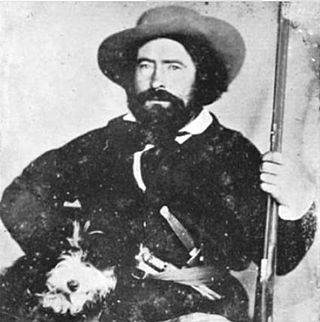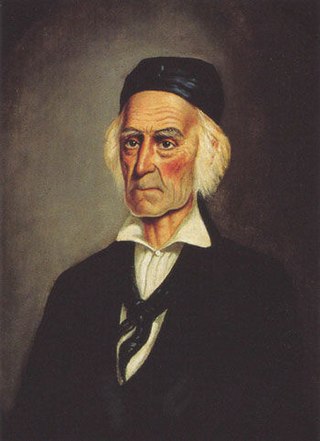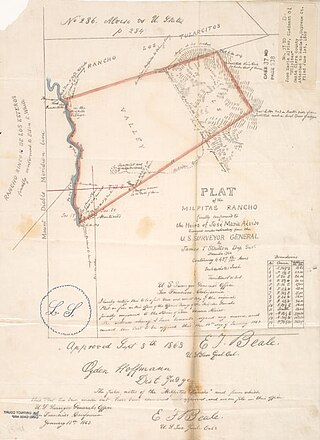Related Research Articles

Jasper O'Farrell (1817–1875) was an Irish-American politician who served as the first surveyor for San Francisco. He designed the "grand promenade" that became today's Market Street. O'Farrell Street in San Francisco is named after him.

The Lugo family of California were prominent during the periods of Spanish and Mexican rule. They were among the early colonists who became known as Californios.

Francisco de Haro was a Californio politician, soldier, and ranchero, who served as the 1st and 5th Alcalde of San Francisco. He notably commissioned the first land survey of San Francisco to Jean Jacques Vioget in 1839.

Rancho Milpitas was a 4,458-acre (18.04 km2) Mexican land grant in Santa Clara County, California. The name comes from the Nahuatl "milpan", a term meaning "in the field". Therefore, Milpitas could be translated as "little fields". The grant included what is now the city of Milpitas.

Rancho Rincón de los Esteros was a 6,353-acre (25.71 km2) Mexican land grant in present-day Santa Clara County, California.
James Alexander Forbes was the British vice-consul to Mexican California as well as the first British consul to the U.S. state of California. He built a flour mill outside of San Jose, California, and that land eventually became the basis of the town of Los Gatos.
Juan Francisco Reyes (1749–1809), soldado de cuera on the 1769 Portola expedition, alcalde of the Pueblo de Los Angeles for three terms, and recipient of the Spanish land grant for Rancho Los Encinos and later Lompoc.
Rancho Cañada de Capay was a 40,079-acre (162.19 km2) Mexican land grant in present-day Yolo County, California given in 1846 by Governor Pío Pico to the three brothers Santiago, Nemicio, and Francisco Berreyesa. "Cañada de Capay" means "valley of the Capay" in Spanish. "Capay" comes from the Southern Wintun Indian word for "stream". The rancho occupied the Capay Valley on both sides of Cache Creek.
Rancho Las Putas was a 35,516-acre (143.73 km2) Mexican land grant in present-day Napa County, California, given in 1843 by Governor Manuel Micheltorena to José de Jesús Berreyesa and Sexto "Sisto" Berreyesa. The name Las Putas came from Putah Creek, which ran through the property. Most of the grant is now covered by Lake Berryessa.
María Gabriela Berreyesa Castro, also known as María Gabriela Berrelleza (1780–1851), was a Californio landowner, from the notable Berryessa family of California.
José de los Reyes Berreyesa, also spelled Berrelleza, was born at Mission Santa Clara de Asís in Las Californias province of the Spanish Viceroyalty of New Spain.
José de los Santos Berreyesa, a member of the Berreyesa family, was the last Alcalde of Alta California. Fluent to a high degree in both English and Spanish, he served as a witness on many land grant cases before the Public Land Commission in the 1850s and 1860s.
Rancho Mallacomes was a 17,742-acre (71.80 km2) Mexican land grant in present-day Napa County and Sonoma County, California given in 1843 by Governor Manuel Micheltorena to José de los Santos Berreyesa.
Rancho San Francisco de las Llagas was a 22,283-acre (90.18 km2) Mexican land grant in present-day Santa Clara County, California given in 1834 by Governor José Figueroa to Carlos Antonio Castro. The grant extended along Llagas Creek from about one mile south of present-day Morgan Hill to about one mile north of Gilroy, and included present-day San Martin.
Rancho Las Uvas was a 11,080-acre (44.8 km2) Mexican land grant in present-day Santa Clara County, California given in 1842 by Governor Juan Alvarado to Lorenzo Pinedo. The name means "ranch of the grapes" and is derived from an abundance of wild grapes along the area's main watercourses. The grant was 3 miles west of present-day Morgan Hill, and covered the hilly area drained by the Uvas Creek and Llagas Creek, and is the site of present-day Uvas Reservoir.

Rancho Rincon de Musalacon was a 8,867-acre (35.88 km2) Mexican land grant in present-day Sonoma County, California given in 1846 by Governor Pío Pico to Francisco Berreyesa. The grant extended along both sides of the Russian River and encompassed present-day Cloverdale and Asti.
Rancho San Vicente was a 4,438-acre (17.96 km2) Mexican land grant in present-day Santa Clara County, California given in 1842 by Governor Juan Alvarado to José de los Reyes Berreyesa. The grant was located west of the Santa Teresa Hills at the south end of Almaden Valley. The grant was bounded on the north by Rancho Los Capitancillos.
Rancho Los Capitancillos was a 3,360-acre (13.6 km2) Mexican land grant in present-day Santa Clara County, California given in 1842 by Governor Juan B. Alvarado to Justo Larios. Los Capitancillos means the Little Captains in Spanish.
Rancho San Juan Bautista was a 8,880-acre (35.9 km2) Mexican land grant in present-day Santa Clara County, California given in 1844 by Governor Manuel Micheltorena to José Agustín Narvaez. The grant extended along the Guadalupe River from Los Gatos to San Jose. Within its boundaries were much of today’s Willow Glen, Hillsdale, Robertsville and the Lone Hill area.

Calero, also known as Calero Lake and occasionally as South Almaden Valley, is a rural neighborhood in the Almaden Valley district of San Jose, California. Located in South San Jose, Calero is notably home to Calero County Park, which surrounds Calero Lake.
References
- Notes
- 1 2 Meier, Matt S.; Margo Gutiérrez. The Mexican American Experience: an Encyclopedia, Greenwood Publishing Group, 2003, p. 44. ISBN 0-313-31643-0.
- ↑ Pitt, 1966, p. 103.
- ↑ Heizer, Robert Fleming, ed. (1974). "2 : Conditions of Indians". The destruction of California Indians. A collection of documents from the period 1847 to 1865 in which are described some of the things that happened to some of the Indians of California. Santa Barbara: Smith. p. 20. ISBN 978-0-87905-009-2.
- 1 2 3 4 5 6 7 8 9 10 11 12 The Berryessa Family. Retrieved on August 16, 2009.
- ↑ Christy, Julia. "California Spanish Genealogy: Directory De Anza." Hosted at SFGenealogy. Retrieved on August 16, 2009.
- 1 2 3 4 5 6 7 8 FamilyTreeMaker.com. Descendants of Luis Cayetano (Berrelleza) Berreyesa Archived 2011-06-06 at the Wayback Machine . Retrieved on August 14, 2009.
- ↑ Winther, Oscar Osburn. California History Magazine, Volume 14, 1935. "The Story of San Jose, 1777–1869, California's First Pueblo, Part I." Hosted at SFGenealogy. Retrieved on August 16, 2009.
- 1 2 The United States vs. Andres Castillero: "New Almaden" : transcript of the record, Volume 1. United States District Court, California, Northern District. 1859.
- 1 2 3 Eldredge, Zoeth Skinner. The Beginnings of San Francisco, 1912. "Appendix D: The Murder of Berreyesa and the De Haros." Archived 2016-03-03 at the Wayback Machine Hosted at SFGenealogy. Retrieved on August 16, 2009.
- ↑ Gonzalez-Day, Ken. Lynching in the West, 1850–1935, Duke University Press, 2006, pp. 4–5, 191, 239. ISBN 0-8223-3794-0
- 1 2 Bancroft, Hubert Howe; Henry Lebbeus Oak; William Nemos; Mrs. Frances Fuller Victor. History of California, 1884.
- ↑ Beale, Howard K. The Diary of Edward Bates 1859–1866, Read Books, 2008, pp. 49, 65–69, 282, 304, 339–342. ISBN 1-4437-3009-2
- 1 2 UC Berkeley. Earth Sciences and Map Library. Mexican Land Grants: Santa Clara County. Retrieved on August 16, 2009.
- ↑ Whitney, Josiah Dwight. The United States: Facts and Figures Illustrating the Physical Geography of the Country, and Its Material Resources, Volume 2, p. 340. Little, Brown, and company, 1889.
- ↑ Pitt, 1966, p. 101.
- ↑ Pitt, 1966, p. 102.
- Bibliography
- Pitt, Leonard M. The Decline of the Californios: A Social History of the Spanish-Speaking Californians, 1846–1890, Berkeley: University of California Press, 1966
- Salonites, Eftimeos. Berreyesa: The Rape of the Mexican Land Grant, Rancho Cañada de Capay, Mission Bell Marketing, 1994.